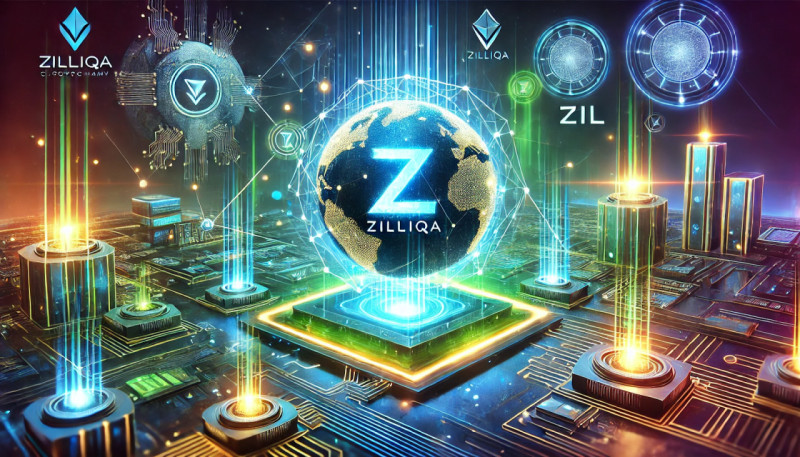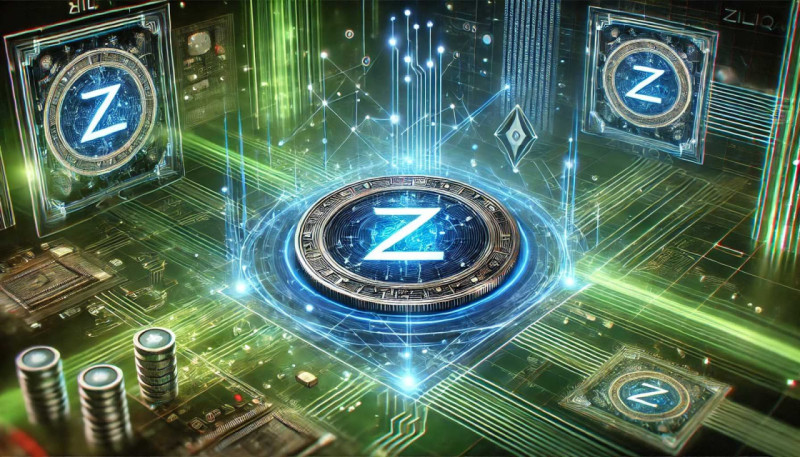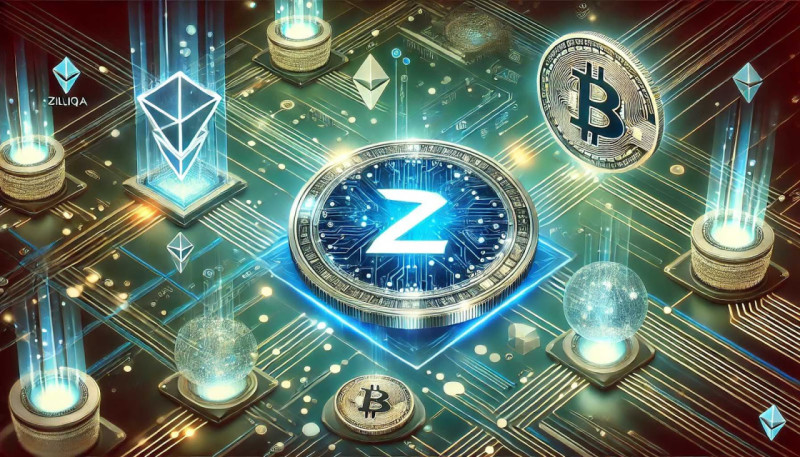
Introduction to ZIL Crypto
Brief Overview of Zilliqa (ZIL) as a Cryptocurrency
Zilliqa (ZIL) is a blockchain platform that focuses on providing high scalability and fast transaction speeds. Launched in 2017, it stands out due to its innovative use of sharding technology. Sharding is a process that divides the network into smaller components, allowing multiple transactions to be processed simultaneously. This makes Zilliqa highly efficient, especially when compared to other blockchain platforms. As a utility cryptocurrency, ZIL powers the network, enabling transactions, smart contract execution, and governance, placing it among the top projects often mentioned in a utility cryptocurrency list for its unique scalability solutions.
The Importance of Zilliqa in the Crypto Space
Zilliqa plays a significant role in the cryptocurrency world by addressing the issue of scalability. One of the main challenges with traditional blockchain platforms, like Bitcoin and Ethereum, is that as more users join, transaction speeds often slow down. Zilliqa's sharding technology helps solve this problem, allowing the network to scale seamlessly as the number of users grows. This makes Zilliqa an appealing choice for decentralized applications (dApps), financial services, and other blockchain-based solutions that require high throughput.
Current Trends and Popularity of ZIL
Zilliqa has been gaining attention due to its focus on scalability and its ability to handle large transaction volumes efficiently. In recent years, it has expanded its ecosystem with partnerships, decentralized finance (DeFi) projects, and non-fungible token (NFT) platforms, contributing to its rising popularity. As of now, ZIL continues to be actively traded on major cryptocurrency exchanges, and its strong technological foundation positions it as a significant player in the evolving blockchain space. The growing interest in DeFi and NFTs has also contributed to renewed attention on the Zilliqa network, helping ZIL maintain its relevance in the fast-paced crypto industry.
What is Zilliqa (ZIL Crypto)?
Background and Founding Team of Zilliqa
Zilliqa was founded in 2017 by a team of researchers and blockchain enthusiasts who recognized the scalability limitations of existing blockchain networks. The project emerged from research conducted at the National University of Singapore and was led by co-founders Prateek Saxena, Amrit Kumar, and Xinshu Dong. The team aimed to create a blockchain that could overcome the challenges of slow transaction speeds and high costs, which plagued earlier platforms like Bitcoin and Ethereum. Since its launch, Zilliqa has grown into a well-established blockchain platform, known for its groundbreaking technology and scalability solutions.
Overview of Zilliqa’s Blockchain Architecture and Purpose
Zilliqa’s blockchain architecture is designed to enhance speed and scalability through a unique process called sharding. Unlike traditional blockchains that process transactions sequentially, Zilliqa divides its network into smaller groups called shards. Each shard processes transactions in parallel, significantly boosting the network's overall throughput. This parallel processing allows Zilliqa to handle thousands of transactions per second, making it an ideal platform for decentralized applications (dApps) that require high-speed processing.
The primary purpose of Zilliqa is to provide a scalable and secure blockchain infrastructure for developers to build dApps and decentralized finance (DeFi) projects. By offering high throughput and low transaction costs, Zilliqa aims to support a wide range of use cases, including digital payments, financial services, gaming, and supply chain management.
ZIL’s Value Proposition: Scalability, Sharding, and Security
Zilliqa’s most significant value proposition lies in its ability to scale efficiently through sharding. Sharding allows the network to grow without compromising speed or security, which is a common issue with other blockchains. As the number of users on the Zilliqa network increases, so does the number of shards, ensuring that transaction processing remains fast and efficient.
Scalability is further supported by Zilliqa’s secure consensus mechanism, which combines proof-of-work (PoW) for identity verification and practical Byzantine Fault Tolerance (pBFT) for transaction validation. This hybrid consensus ensures the network remains both secure and decentralized. Additionally, Zilliqa's use of a custom smart contract language, Scilla, helps improve security by reducing the risk of common vulnerabilities found in smart contracts.
How Does ZIL Crypto Work?
Zilliqa’s Unique Technology: Sharding
At the core of Zilliqa's innovative approach is the concept of sharding. Sharding divides the Zilliqa network into smaller subnetworks called shards, each capable of processing transactions in parallel. This means that as the network grows and more nodes join, the number of shards increases, and each shard can handle its own subset of transactions. Instead of relying on the entire network to process every transaction like traditional blockchains, Zilliqa distributes the workload across multiple shards. This parallel processing significantly enhances the network’s throughput and efficiency, making it one of the fastest blockchain platforms available.
How Sharding Solves the Scalability Problem in Blockchain
Scalability has been a significant hurdle for most blockchain platforms, especially as their user base grows. Traditional blockchains like Bitcoin and Ethereum experience slower transaction speeds and higher fees when the network becomes congested. Zilliqa addresses this issue through sharding, which enables the network to scale linearly with the number of shards.
For example, if the network has two shards, it can process twice as many transactions per second compared to a single shard. As more shards are added, the network can handle a proportional increase in transaction volume without sacrificing speed. This solution makes Zilliqa highly scalable, offering a sustainable way to accommodate growth while maintaining performance, even during periods of high demand.
The Consensus Mechanism: Practical Byzantine Fault Tolerance (PBFT)
Zilliqa uses a hybrid consensus mechanism to ensure both security and efficiency. It combines Proof-of-Work (PoW) with Practical Byzantine Fault Tolerance (PBFT). PoW is used primarily to establish identities and prevent Sybil attacks, but it is not required for every transaction. Once identities are verified, PBFT takes over to validate transactions and reach consensus across the network.
PBFT is a consensus protocol designed to maintain high security even if some nodes in the network act maliciously. It allows Zilliqa to achieve finality in transaction confirmation, meaning once a transaction is confirmed, it cannot be reversed or altered. This ensures a secure and reliable network without the need for constant PoW mining, reducing energy consumption and transaction costs.
Real-World Use Cases of Zilliqa's Blockchain
Zilliqa’s unique technology makes it suitable for various real-world applications, particularly those requiring high throughput and fast transaction speeds. Some of the most notable use cases include:
- Decentralized Finance (DeFi): Zilliqa's scalable infrastructure is ideal for building DeFi platforms that require handling a high volume of transactions, such as lending, borrowing, and decentralized exchanges.
- Non-Fungible Tokens (NFTs): Zilliqa has entered the NFT space, enabling creators to mint and trade digital assets with low fees and fast transaction times.
- Digital Advertising: Zilliqa has partnered with companies like Aqilliz to create blockchain-based solutions for digital advertising, ensuring transparency and fair compensation for both advertisers and consumers.
- Gaming: With its fast and scalable platform, Zilliqa is also being used to power blockchain-based games that require a high number of transactions per second.
These real-world use cases demonstrate Zilliqa's versatility and potential to transform industries that rely on fast, scalable, and secure blockchain solutions.

ZIL Token: Utility and Use Cases
The Purpose of the ZIL Token within the Zilliqa Ecosystem
ZIL is the native cryptocurrency of the Zilliqa blockchain, playing a crucial role in the ecosystem's functionality. It is used to facilitate transactions, pay for gas fees, and execute smart contracts on the platform. ZIL also acts as a medium of exchange within the Zilliqa network, incentivizing participants to contribute to the blockchain’s security and operational efficiency. As the backbone of the Zilliqa ecosystem, ZIL helps maintain the integrity of the network while providing users with a versatile token for a range of applications.
Common Use Cases of ZIL Crypto
- Payments:
ZIL can be used for making fast, low-fee payments within the Zilliqa ecosystem. The platform's high throughput ensures that transactions are processed quickly, making it an efficient choice for both peer-to-peer payments and business transactions. - Staking:
ZIL holders can stake their tokens to participate in securing the network and validating transactions. By staking ZIL, users contribute to the consensus mechanism and earn rewards in return. Staking also incentivizes long-term engagement with the network and helps maintain its decentralized security. Stakers can earn rewards based on the amount of ZIL they hold and contribute to the pool. - Smart Contracts:
Developers use ZIL to pay for the execution of smart contracts on Zilliqa’s blockchain. Smart contracts enable a wide range of decentralized applications (dApps), such as decentralized finance (DeFi) platforms and non-fungible token (NFT) projects. The use of ZIL for transaction fees ensures that smart contracts run efficiently and securely on the platform. - Governance:
Although not fully implemented yet, Zilliqa is working toward decentralized governance, where ZIL holders will have the power to vote on network upgrades, proposals, and key decisions that shape the future of the ecosystem.
ZIL Tokenomics: Supply, Distribution, and Staking Rewards
Zilliqa has a total maximum supply of 21 billion ZIL tokens, which helps control inflation and maintain scarcity over time. The distribution of ZIL tokens was handled through an initial token generation event, where a portion was allocated to early investors, the founding team, and the Zilliqa ecosystem development fund. A large portion of the tokens was reserved for mining rewards to incentivize network participants and validators.
- Supply:
As of now, around 16 billion ZIL tokens are in circulation, with the remaining tokens gradually being released through network participation and staking rewards. This controlled release helps maintain a balance between demand and supply, which is crucial for the long-term sustainability of the token’s value. - Staking Rewards:
ZIL staking allows participants to lock up their tokens and earn rewards. Stakers can receive an annual percentage yield (APY), which is distributed in ZIL tokens. The exact APY depends on the number of tokens staked and the overall participation in the staking pool. Staking helps secure the network and incentivizes users to hold their ZIL, contributing to the token’s long-term stability and ecosystem engagement.
In summary, ZIL serves multiple functions within the Zilliqa ecosystem, from facilitating payments and enabling smart contract execution to providing staking rewards and potentially influencing future governance decisions. Its tokenomics, including supply control and staking incentives, ensure a balanced and sustainable economic model for the Zilliqa blockchain.
ZIL Crypto Price Trends and Predictions
Historical Price Trends of ZIL
Zilliqa (ZIL) has experienced notable fluctuations in price since its launch in 2017, reflecting the volatility of the broader cryptocurrency market. ZIL debuted in the market during the crypto boom of late 2017 and early 2018, reaching its initial all-time high in May 2018 at around $0.23. However, like many cryptocurrencies, ZIL’s price saw a significant decline during the 2018 bear market, dropping to less than $0.01 by the end of that year.
ZIL’s price remained relatively low and stable throughout 2019 and most of 2020. However, in early 2021, the entire cryptocurrency market saw a resurgence, driven by the rise of decentralized finance (DeFi) and non-fungible tokens (NFTs), as well as general market enthusiasm. During this bull run, ZIL hit a new peak in May 2021, with its price climbing to approximately $0.25.
After this high, ZIL’s price followed the broader market’s downward trend, experiencing corrections and market volatility throughout 2022. While prices have fluctuated since, ZIL continues to remain a key player in the crypto market due to its robust technology and expanding ecosystem.
Key Factors Influencing the Price of Zilliqa
- Adoption and Partnerships:
As Zilliqa builds partnerships and integrates with new projects, especially in the decentralized finance (DeFi) and NFT sectors, the demand for ZIL increases. Successful partnerships and technological advancements, such as its growing involvement in digital advertising and blockchain gaming, positively affect ZIL’s price. - Network Upgrades and Development:
Zilliqa’s ability to scale through sharding and the continuous improvements in its blockchain technology play a key role in its price movements. If the platform introduces major upgrades or launches new features, the price of ZIL could see a significant boost. - Market Sentiment and Speculation:
Like most cryptocurrencies, ZIL is heavily influenced by overall market sentiment. During bullish periods, when the entire crypto market is rising, ZIL benefits from increased investor interest. Conversely, bearish market conditions tend to drive down prices. Speculation from retail and institutional investors can also lead to price volatility. - Competition in the Blockchain Space:
Zilliqa operates in a highly competitive environment, with blockchains like Ethereum, Solana, and Avalanche offering similar services. The performance of these competing platforms can affect ZIL’s price. If Zilliqa maintains a competitive edge in terms of scalability, low fees, and speed, its value could rise. However, losing ground to competitors may negatively impact the price. - Staking and Supply Dynamics:
ZIL’s tokenomics, including its staking rewards and fixed maximum supply of 21 billion tokens, create a deflationary mechanism that supports its price. Increased staking can reduce the circulating supply of ZIL, potentially driving up demand and price, especially during periods of high staking participation.
Market Predictions and Expert Analysis on ZIL’s Future Price Movements
Experts and market analysts have varying predictions about the future of ZIL, but many agree that its innovative technology positions it well for future growth.
- Short-term Predictions:
Some analysts predict that ZIL could experience moderate growth in the short term if the broader crypto market recovers from recent bearish trends. As of now, ZIL’s price is closely tied to market sentiment, and any positive news regarding partnerships, technological advancements, or DeFi/NFT adoption could result in price increases. - Long-term Predictions:
In the long term, Zilliqa’s unique sharding technology and ability to scale may drive further adoption, which could significantly boost its price. Some experts believe ZIL could return to or surpass its 2021 highs, especially if the platform continues to secure strategic partnerships and expand its ecosystem. Bullish predictions suggest that ZIL could reach anywhere between $0.50 and $1 over the next few years, depending on market conditions and the continued growth of the Zilliqa ecosystem. - Bearish Outlook:
On the other hand, a bearish scenario would likely occur if Zilliqa faces increased competition, fails to maintain network upgrades, or if the overall crypto market enters another prolonged downtrend. In this case, ZIL’s price could remain stagnant or decline further.
In summary, while ZIL’s price is subject to market volatility, its technological strengths and potential for further adoption provide a promising outlook. However, as with all cryptocurrencies, price predictions should be approached with caution, as they depend on a wide range of market and external factors.

How to Buy and Store ZIL Crypto
Step-by-Step Guide on Buying ZIL on Major Exchanges
Buying ZIL is a straightforward process, and it can be done on most major cryptocurrency exchanges. Here’s a step-by-step guide:
- Choose a Crypto Exchange:
ZIL is listed on numerous popular exchanges, such as Binance, Coinbase, KuCoin, Kraken, and Crypto.com. Choose an exchange based on availability in your country, fees, and ease of use. - Create an Account:
If you don’t already have an account on a crypto exchange, you’ll need to sign up. This process typically involves providing your email, setting up a password, and completing a Know Your Customer (KYC) verification, which may include submitting identification documents. - Deposit Funds:
Once your account is verified, you’ll need to deposit funds to purchase ZIL. Most exchanges allow deposits in major fiat currencies (USD, EUR, etc.) via bank transfer or credit/debit card. Alternatively, you can deposit other cryptocurrencies, such as Bitcoin (BTC) or Ethereum (ETH), which can be exchanged for ZIL. - Buy ZIL:
After depositing funds, navigate to the trading section of the exchange. Search for ZIL using its ticker symbol. You can buy ZIL by placing a market order (buy at the current price) or a limit order (set your own price). Once your order is filled, ZIL will appear in your exchange wallet. - Withdraw to a Personal Wallet:
For added security, it’s advisable to withdraw your ZIL to a personal wallet rather than leaving it on the exchange. Exchanges are vulnerable to hacks, so using a private wallet reduces the risk of losing your funds.
Overview of Wallets that Support ZIL Tokens
Once you’ve purchased ZIL, it’s essential to store it in a secure wallet. Here’s an overview of different types of wallets that support ZIL:
- Software Wallets:
Software wallets are convenient and accessible via desktop or mobile devices. Popular ZIL-compatible software wallets include:- ZilPay: A browser extension wallet designed specifically for Zilliqa, allowing users to manage ZIL tokens and interact with dApps.
- Trust Wallet: A mobile wallet that supports ZIL along with a wide range of other cryptocurrencies.
- Atomic Wallet: A multi-currency wallet available on desktop and mobile, offering users the ability to store and stake ZIL tokens.
- Moonlet: A simple, user-friendly wallet that allows users to store and stake ZIL securely.
- Hardware Wallets:
Hardware wallets offer the highest level of security for storing cryptocurrencies by keeping your private keys offline. Some leading hardware wallets that support ZIL include:- Ledger Nano S and Nano X: Popular hardware wallets known for their top-notch security and support for a wide range of cryptocurrencies, including ZIL.
- Trezor: Another highly secure hardware wallet that supports ZIL and ensures your private keys are never exposed to online threats.
- Web Wallets:
Zilliqa offers a native web wallet for those who prefer an easy-to-access, browser-based option. However, web wallets are generally less secure than software or hardware options and should be used with caution.
Importance of Secure Storage and Private Key Management
Securing your ZIL tokens and properly managing your private keys is crucial for protecting your investment. Here are some key practices to follow:
- Use a Hardware Wallet:
For large amounts of ZIL, it’s best to store them in a hardware wallet. These wallets keep your private keys offline, making them resistant to hacking attempts and malware. - Backup Your Private Keys and Recovery Phrases:
When setting up a wallet, you’ll be provided with a private key or recovery phrase. This is the only way to recover your funds if you lose access to your wallet. Always store this information in a safe, offline location. Never share your private key or recovery phrase with anyone. - Enable Two-Factor Authentication (2FA):
For extra security, enable 2FA on any account that holds your cryptocurrency, including exchange accounts and wallet apps. This provides an added layer of protection against unauthorized access. - Avoid Keeping Funds on Exchanges:
Although exchanges provide convenience, they are more susceptible to hacking. It’s recommended to transfer your ZIL to a personal wallet where you control the private keys.
By following these guidelines, you can ensure your ZIL tokens are stored securely and your investment is well-protected from potential threats.
Zilliqa vs Competitors (ZIL Crypto vs Other Cryptos)
Zilliqa competes with other blockchain platforms like Ethereum, Polkadot, and Cardano, each offering different solutions for scalability, decentralization, and security. Here’s how Zilliqa stacks up against these major competitors.
Zilliqa vs Ethereum (ETH)
Zilliqa focuses on scalability through its sharding technology, which allows it to process thousands of transactions per second. In contrast, Ethereum currently faces issues with scalability but is transitioning to Ethereum 2.0, which will also use sharding. Zilliqa’s hybrid consensus model combines Proof-of-Work for identity verification with Practical Byzantine Fault Tolerance for transaction consensus. Ethereum, on the other hand, uses Proof-of-Work but is shifting to Proof-of-Stake with Ethereum 2.0. When it comes to fees, Zilliqa offers much lower transaction costs, while Ethereum is notorious for its high gas fees. While Ethereum remains the leader in smart contracts and has a vast ecosystem of decentralized applications (dApps), Zilliqa is gradually growing its own ecosystem.
Zilliqa vs Polkadot (DOT)
Both Zilliqa and Polkadot are designed to improve scalability, but they approach it differently. Zilliqa uses sharding to split the network and process transactions in parallel, while Polkadot relies on parachains, which are individual blockchains that operate alongside the main relay chain. A key difference is Polkadot’s focus on interoperability, which allows different blockchains to communicate and share data. Zilliqa is more focused on high throughput and building dApps rather than enabling cross-chain functionality. Polkadot also uses a unique governance structure, giving token holders significant influence over network decisions, whereas Zilliqa’s governance features are still evolving.
Zilliqa vs Cardano (ADA)
Zilliqa and Cardano are both designed to be highly scalable blockchain platforms, but their technology differs. Zilliqa relies on sharding, while Cardano uses a layered architecture that separates the settlement and computation layers to improve scalability. Cardano uses a Proof-of-Stake consensus mechanism called Ouroboros, which is highly energy-efficient. Zilliqa, in comparison, uses a hybrid consensus model. Cardano is known for its research-driven approach, focusing on peer-reviewed scientific methods in its development. Both platforms are focused on building decentralized applications, but Cardano has a broader focus on academic research and ensuring long-term scalability and sustainability.

Key Differences: Comparison Table
| Feature | Zilliqa (ZIL) | Ethereum (ETH) | Polkadot (DOT) | Cardano (ADA) |
| Consensus Mechanism | PoW + PBFT | PoW (shifting to PoS) | Nominated Proof of Stake | Proof of Stake (Ouroboros) |
| Scalability Approach | Sharding | Sharding (in Ethereum 2.0) | Parachains | Layered Architecture |
| Transaction Speed | Thousands of TPS | 15–30 TPS (ETH 1.0) | High with parachains | High with PoS |
| Transaction Fees | Low | High (ETH 1.0) | Low | Low |
| Interoperability | Limited | Limited | High | Limited |
| Smart Contract Ecosystem | Growing | Extensive | Developing | Developing |
| Governance | Evolving | Developer-led | On-chain governance | Off-chain governance |
| Launch Year | 2017 | 2015 | 2020 | 2017 |
Zilliqa stands out for its early adoption of sharding to tackle scalability, offering fast and low-cost transactions. However, Ethereum dominates the dApp and smart contract landscape, though it currently struggles with scalability issues. Polkadot offers unparalleled interoperability, making it a strong contender for cross-chain applications. Cardano, with its focus on academic research and energy efficiency, positions itself as a sustainable, long-term solution. Each of these platforms has unique strengths, depending on the needs of developers and users in the blockchain ecosystem.
Pros and Cons of ZIL Crypto
Pros:
- Scalable Solution via Sharding
Zilliqa was the first blockchain to implement sharding, allowing it to process thousands of transactions per second. This scalable solution makes Zilliqa well-suited for decentralized applications (dApps) that require high throughput, such as financial services, gaming, and digital advertising. - Low Transaction Fees
Due to its efficient architecture, Zilliqa offers significantly lower transaction fees compared to many other blockchains, particularly Ethereum. This makes it an attractive option for users who require frequent transactions or dApps that need to handle large volumes without incurring high costs. - Strong Development Team and Growing Ecosystem
Zilliqa has a dedicated team of developers and researchers with a strong academic background. The platform’s continuous development and innovation in areas like decentralized finance (DeFi) and non-fungible tokens (NFTs) contribute to its expanding ecosystem. Partnerships with industry leaders further enhance Zilliqa's potential for future growth.
Cons:
- Relatively Lower Adoption Compared to Ethereum
Despite its technological advantages, Zilliqa has yet to achieve the widespread adoption of competitors like Ethereum. While its ecosystem is growing, it currently has fewer developers, dApps, and users compared to the more established Ethereum network. This can limit the network effects that drive greater usage and innovation. - Regulatory Risks in the Crypto Market
Like all cryptocurrencies, ZIL is subject to potential regulatory risks. Governments around the world are increasingly scrutinizing digital currencies, and future regulations could impact Zilliqa's operations or its value. These uncertainties create challenges for long-term stability and adoption in heavily regulated markets.
Zilliqa offers significant benefits in terms of scalability, low fees, and a growing ecosystem, but it faces challenges such as lower adoption compared to major competitors and the unpredictable nature of regulatory developments in the cryptocurrency space.
Zilliqa’s Future Roadmap and Developments
Key Milestones Zilliqa Aims to Achieve
Zilliqa has set several ambitious milestones to strengthen its position as a leading blockchain platform. Some key areas of focus include:
- Expansion of DeFi Ecosystem
Zilliqa aims to build a robust decentralized finance (DeFi) ecosystem by introducing more decentralized exchanges (DEXs), lending protocols, and yield farming options. By fostering partnerships with existing DeFi projects and launching new platforms, Zilliqa hopes to attract more users and liquidity to its network. - NFT Market Growth
The platform is looking to expand its presence in the non-fungible token (NFT) space by supporting new NFT projects and marketplaces. With NFTs gaining traction globally, Zilliqa aims to become a prominent player in this rapidly growing industry. - Governance and Decentralization
Zilliqa is working towards implementing decentralized governance, giving ZIL holders a more active role in decision-making. Through voting mechanisms, the community will be able to influence protocol updates, development directions, and key partnerships.
Upcoming Updates and Developments in the Zilliqa Ecosystem
- Metapolis (Zilliqa's Metaverse)
Zilliqa is developing Metapolis, a virtual metaverse built on its blockchain. This platform will allow users to create and interact in a digital world, further increasing engagement and potential use cases for ZIL. Metapolis is expected to bring new audiences, especially in gaming, virtual real estate, and digital identity. - EVM Compatibility
Zilliqa plans to introduce Ethereum Virtual Machine (EVM) compatibility, which would allow Ethereum-based dApps to be easily ported over to the Zilliqa blockchain. This update will make it easier for developers to build on Zilliqa and could drive more adoption by offering seamless integration for existing Ethereum projects. - Zilliqa 2.0
The team is working on Zilliqa 2.0, a major network upgrade aimed at improving efficiency, security, and scalability. This upgrade is expected to further enhance transaction speeds and lower fees while also improving the overall user experience on the platform.
How These Developments Could Impact the ZIL Crypto and Its Adoption
The upcoming developments on Zilliqa’s roadmap could have a significant positive impact on the value and adoption of the ZIL token. As the DeFi and NFT ecosystems expand, demand for ZIL is likely to increase, especially for transaction fees, staking, and participating in smart contracts. The launch of Metapolis, with its potential to attract users from gaming and virtual worlds, could further drive ZIL's utility.
The introduction of EVM compatibility is expected to lower the barrier for Ethereum developers to migrate to Zilliqa, which could lead to a surge in new dApps being built on the platform. This expansion could increase the number of transactions and activities on Zilliqa, driving up demand for ZIL.
Finally, the network upgrade to Zilliqa 2.0 will likely make the platform more attractive to both developers and users, further boosting its competitiveness against other major blockchain platforms. If successful, these developments could position Zilliqa as a more widely adopted blockchain, leading to greater demand and price appreciation for the ZIL token.

Conclusion
Zilliqa stands out as a highly scalable blockchain platform due to its pioneering use of sharding technology. This enables it to process thousands of transactions per second, making it an efficient choice for decentralized applications (dApps) and enterprises that need high throughput. The platform’s low transaction fees, strong development team, and expanding ecosystem, particularly in decentralized finance (DeFi), non-fungible tokens (NFTs), and the metaverse, further bolster its appeal.
In terms of investment potential, ZIL offers significant promise. Its unique technological foundation, ongoing developments such as EVM compatibility, Zilliqa 2.0, and the growing adoption of DeFi and NFTs on its network position it well for long-term growth. However, like all cryptocurrencies, ZIL’s value is subject to market volatility and regulatory risks. For investors with a high-risk tolerance, ZIL’s technological advancements and ambitious roadmap could make it a promising addition to a diversified cryptocurrency portfolio.
In summary, Zilliqa’s combination of scalability, innovation, and future development plans makes it a strong contender in the blockchain space, with the potential for significant growth in the years ahead.
Recommended
Is Gala Crypto a Good Investment





